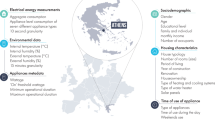Abstract
Knowing household properties, such as number of persons per apartment, age of housing, type of water heating, etc. enables energy consultants and utilities to develop targeted energy conservation services. Load profiles captured by smart power meters, can—besides several other applications—be used to reveal energy efficiency relevant household characteristics. The goal of this work is to develop methods of supervised machine learning that deduce properties of private dwellings using consumption time series recorded in 30-min intervals. The contribution of this paper to the state of the art is threefold: we quadruplicate the number of features that describe power consumption curves to preserve classification relevant structures, indicate dimensionality reduction techniques to reduce the large-scale input data to a set of few significant features and finally, we redefine classes for some properties. As a result, the classification accuracy is elevated up to 82 %, while the runtime complexity is significantly reduced. The classification quality that can be achieved by our eCLASS methodology renders personalized efficiency measures in large-scale practical settings possible.





Similar content being viewed by others
Notes
In [2] the normalization step is performed over the whole dataset, which might leads to inflated results, because the training data is not independent form the test data.
There exist two clusters: one of 52 very high correlated features (\(\vert r\vert \gg 0.4)\) and one of 36 low correlated features \((\left| r \right| <0.36)\)
References
Degen K, Efferson C, Frei F, Goette L, Lalive R (2013) Smart Metering, Beratung oder Sozialer Vergleich: Was beeinflusst den Elektrizitätsverbrauch?, Zürich
Beckel C, Sadamori L, Santini S (2013) Automatic socio-economic classification of households using electricity consumption data. In: Culler D, Rosenberg C (eds) Proceedings of the fourth international conference on future energy systems. ACM, Berkeley, pp 75–86
ISSDA (2014) Data from the Commission for Energy Regulation.http://www.ucd.ie/issda/data/commissionforenergyregulationcer/. Accessed 4 March 2014
Verdu SV, Garcia MO, Senabre C, Marin AG, Franco FJG (2006) Classification, filtering, and identification of electrical customer load patterns through the use of self-organizing maps. IEEE Trans Power Syst 21(4):1672–1682
de Silva D, Xinghuo Y, Alahakoon D, Holmes G (2011) A data mining framework for electricity consumption analysis from meter data. IEEE Trans Ind Inf 7(3):399–407
Chicco G, Napoli R, Postolache P, Scutariu M, Toader C (2003) Customer characterization options for improving the tariff offer. IEEE Trans Power Syst 18(1):381–387
Räsänen T, Ruuskanen J, Kolehmainen M (2008) Reducing energy consumption by using self-organizing maps to create more personalized electricity use information. Appl Energy 85(9):830–840
Figueiredo V, Rodrigues F, Vale Z, Gouveia JB (2005) An electric energy consumer characterization framework based on data mining techniques. IEEE Trans Power Syst 20(2):596–602
Sánchez IB, Espinos ID, Moreno Sarrion L, Quijano Ló pez A, Burgos IN (2009) Clients segmentation according to their domestic energy consumption by the use of self-organizing maps. In: 6th international conference on the European energy market, 2009, EEM 2009, pp 1–6
Zeifman M, Roth K (2011) Nonintrusive appliance load monitoring: review and outlook. IEEE Trans Consum Electron 57(1):76–84
Hart GW (1992) Nonintrusive appliance load monitoring. Proc IEEE 80(12):1870–1891
Beckel C, Sadamori L, Santini S (2012) Towards automatic classification of private households using electricity consumption data. In: Pappas GJ (ed) Proceedings of the fourth ACM workshop on embedded sensing systems for energy-efficiency in buildings. ACM, Toronto, pp 169–176
Ramsey FL, Schafer DW (2002) The statistical sleuth: a course in methods of data analysis, 2nd edn. Duxbury, Pacific Grove
Guyon I, Elisseeff A (2003) An introduction to variable and feature selection’. J Mach Learn Res 3:1157–1182
Hall MA (1999) Correlation-based feature selection for machine learning. Dissertation, The University of Waikato
Biesiada J, Duch W (2005) Feature selection for high-dimensional data: a Kolmogorov–Smirnov correlation-based filter. In: Proceedings of the 4th international conference on computer recognition systems, CORES’05. Springer, pp 95–103.
Saeys Y, Inza I, Larranaga P (2007) A review of feature selection techniques in bioinformatics. Bioinformatics 23(19):2507–2517
Richardson JTE (2011) Eta squared and partial eta squared as measures of effect size in educational research. Educ Res Rev 6(2):135–147
Meyer D, Dimitriadou E, Hornik K, Weingessel A, Leisch F (2014) e1071: misc functions of the Department of Statistics (e1071), TU Wien
Han J, Kamber M, Pei J (2012) Data mining: concepts and techniques, 3rd edn. Elsevier, Amsterdam
Author information
Authors and Affiliations
Corresponding author
Rights and permissions
About this article
Cite this article
Hopf, K., Sodenkamp, M., Kozlovkiy, I. et al. Feature extraction and filtering for household classification based on smart electricity meter data. Comput Sci Res Dev 31, 141–148 (2016). https://doi.org/10.1007/s00450-014-0294-4
Published:
Issue Date:
DOI: https://doi.org/10.1007/s00450-014-0294-4




